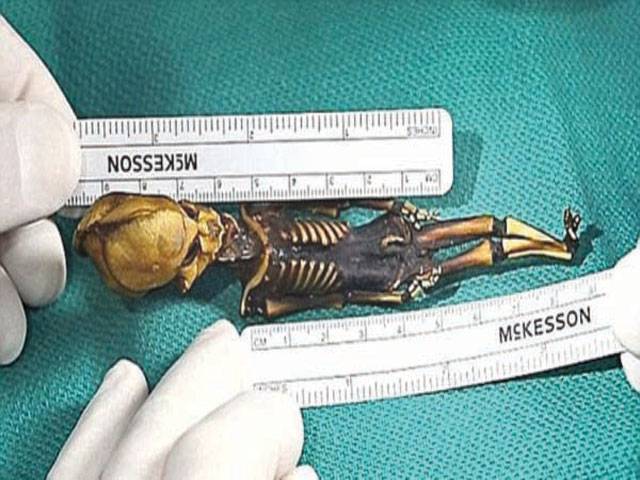LONDON-A mysterious 6-inch skeleton found in Chile’s Atacama Desert has perplexed scholars and the public alike since it was discovered more than a decade ago.
With its tiny stature and features that appear both human and somehow not, many speculated that the abandoned mummy may have extraterrestrial origins.
A study published this year seemed to finally lift the lid on the case, after researchers conducted a skeletal and genomic analysis on the remains and concluded ‘Ata’ was, in fact, a human girl with genetic abnormalities, including ‘accelerated bone age.’
The research, however, was met with instant backlash as many questioned the findings and the ethics of the study itself.
A new effort led by an international team of researchers is now challenging the work, claiming the genomic analyses were unjustified and the skeleton is actually that of a typically developing fetus at around the 15-week point.
The mysterious mummy, nicknamed Ata, was found in the Atacama Desert in 2003 and eventually ended up in the hands of a Spanish collector, before it became the subject of a documentary and later studies led by Stanford University researcher, Garry Nolan.
The most recent study, published this past March in the journal Genome Research, sparked such immediate debate that the authors, including Nolan, issued a statement defending it just days later.
According to the Chilean government and scientists critical of the work, the skeleton was taken out of the country illegally, and the subsequent studies should never have been done.
A new investigation calls the research even further into question, citing concerns on both the ethics and the skeletal and genomic analyses.
‘Unfortunately, there was no scientific rationale to undertake genomic analyses of Ata because the skeleton is normal, the identified genetic mutations are possibly coincidental, and none of the genetic mutations are known to be strongly associated with skeletal pathology that would affect the skeleton at this age,’ says University of Otago bioarchaeologist Associate Professor Sian Halcrow.
‘This case study allows us to showcase how drawing together multiple experts in osteology, medicine, archaeology, history and genetics is essential for accurate scientific interpretations and for considering the ethical implications of genomic analysis.
‘A nuanced understanding of skeletal biological processes and cultural context is essential for accurate scientific interpretation and for acting as a check on the ethics and legality of such research.’
The international team broke the previous research down to a number of seemingly problematic points surrounding the methods, and claims about the skeleton’s age, development, and associated mutations.
The authors, for example, had pointed to the fact that Ata had only 10 pairs of ribs, instead of ‘the normal 12,’ as evidence to support their claims of abnormality.
But, as the new study notes, these so-called ‘floating ribs’ may simply not have begun to form yet at this stage.
It also casts doubts on the apparently ‘elongated skull,’ arguing that it appears normal for a preterm fetus that has been delivered.
‘Taken together, none of the methods or findings regarding Ata’s skeletal age presented by Bhattacharya and colleagues meet the accepted standards for age estimation using bioarchaeological, forensic, or paediatric/obstetric techniques,’ the authors of the new paper argue.
Adding to the ethical concerns, the researchers say this is likely a case of miscarriage, and could be from the recent past.
‘This mummy reflects a sad loss for a mother in the Atacama Desert,’ says Dr Bernardo Arriaza, a bioarchaeologist from the University of Tarapacá in Chile.
The controversy raises important questions on the ethics of archaeological and genomic research, especially in situations where the legality of the samples are unclear.
‘We caution DNA researchers about getting involved in cases that lack clear context and legality, or where the remains have resided in private collections,’ Halcrow says.
‘In the case of Ata, costly and time-consuming scientific testing using the whole genome techniques was unnecessary.’






